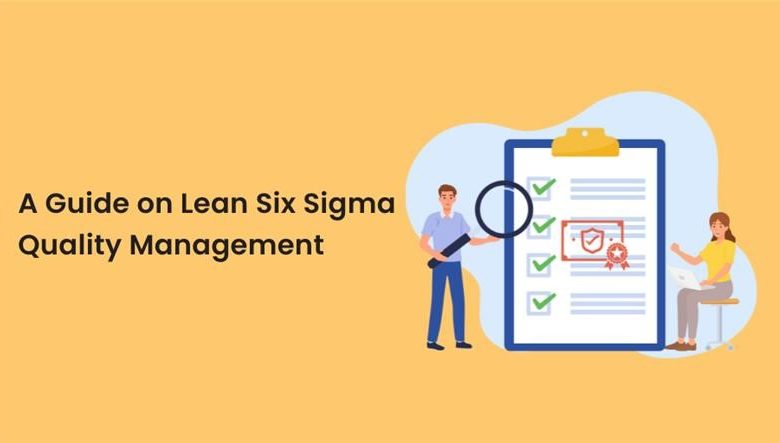A Guide on Lean Six Sigma Quality Management

Lean Six Sigma, a strong and data-driven technique, has developed as a popular approach to quality management excellence. Pursuing a Lean Six Sigma Certification might be a worthwhile investment if you want to develop your abilities in process improvement and quality assurance. In this thorough book, we will look at the ideas and practises of Lean Six Sigma Quality Management and how they can help organisations transform by decreasing defects, increasing efficiency, and increasing customer happiness.
Table of contents
- Understanding Lean Six Sigma Quality Management
- Key Principles of Lean Six Sigma
- Phases of Lean Six Sigma
- Benefits of Lean Six Sigma Quality Management
- Types of Lean Six Sigma Certifications
- The Certification Process
- Conclusion
Understanding Lean Six Sigma Quality Management
Lean Six Sigma combines two well-known methodologies: Six Sigma, which focuses on eliminating waste and enhancing efficiency, and Lean, which focuses on lowering variance and flaws in processes. They create a formidable mix that can be used to improve process performance and deliver goods and services of greater quality.
Key Principles of Lean Six Sigma
Here are some of the key principles of Lean Six Sigma:
- Customer Value Priority: Lean Six Sigma gives the customer priority in actions to improve processes. To ensure customer satisfaction, it is important to understand their needs and provide them with valuable products or services.
- Data-driven Decision: Lean Six Sigma relies on data and statistical analysis to find the underlying causes of problems and arrive at informed decisions.
- Continuous Improvement: Pursuing continuous improvement is a fundamental tenet of Lean Six Sigma. Finding and eliminating process waste, defects, and inefficiencies must be done thoroughly.
- DMAIC Methodology: A systematic problem-solving method used in Six Sigma efforts to improve processes. DMAIC stands for “Define, Measure, Analyse, Improve, Control.”
- Standardisation and Replication: Lean Six Sigma aims to create repeatable, standardised procedures and reliably produce high-quality results.
- Employee commitment: Lean Six Sigma programmes require strong employee engagement and commitment. Employee participation in projects aimed at streamlining processes and fixing problems is encouraged.
Phases of Lean Six Sigma
The Lean Six Sigma approach is generally implemented in the following stages:
- At this stage, the project team defines the project’s purpose, scope, goals, and deliverables. The team also determines key stakeholders and establishes the project’s baseline performance.
- Information is acquired and processed in the measure phase to understand the current process performance. To evaluate the process’s effectiveness and efficiency, metrics and key performance indicators (KPIs) are defined.
- In the analysis phase, comprehensive data analysis identifies the root causes of process inconsistencies and challenges. Regression analysis and cause-and-effect diagrams are common methods used in this phase.
- In the enhancement phase, potential fixes for process issues are found and implemented. The project team uses various improvement techniques, such as lean principles and statistical tools, to enhance the process.
- Maintaining the gains made in the earlier phases is the focus of the control phase. To track and maintain the improved process performance, control plans are devised.
Types of Lean Six Sigma Certifications
Many levels of Lean Six Sigma certification are available, each catering to people with differing degrees of experience and skill. The following are the most prevalent Lean Six Sigma certifications:
- White Belt: A basic introduction to Lean Six Sigma concepts for people looking to get a firm grasp.
- Yellow Belt: This level is ideal for team members working on improvement efforts as it offers a more in-depth understanding of Lean Six Sigma tools and procedures.
- Green Belt: A more prestigious credential for individuals in charge of leading projects for improvement within their organisations or divisions.
- Black Belt: This title is only given to experts who can steer complex improvement projects, mentor Green Belts, and encourage strategic improvements across the entire organisation.
- Master Black Belt: The Master Black Belt certification is the highest level attainable for Lean Six Sigma experts. This certification is designed for those who provide guidance and advice to Black Belts and Green Belts.
The Certification Process
The following steps are commonly included in the Lean Six Sigma certification process:
- Choose the certification level that best fits your current skill set and career goals.
- Enrol in a reputable Lean Six Sigma training programme to gain the necessary knowledge and skills. Training programmes address Lean Six Sigma concepts’ methods, resources, and practical application.
- After finishing the curriculum, you must pass a certification exam in order to receive the Lean Six Sigma certificate. The exam evaluates your knowledge of Lean Six Sigma principles and practical application skills.
- As part of the certification process for some certifications, such as Green Belt and Black Belt, you may be required to complete a genuine improvement project. This project gives you the opportunity to apply Lean Six Sigma approaches to a real-world business problem.
- You may have to meet recurring criteria to keep your Lean Six Sigma certification. Earning continuing education credits or proving engagement in Lean Six Sigma initiatives might be examples of this.
Benefits of Lean Six Sigma Quality Management
Lean Six Sigma has various advantages for organisations looking to improve their quality management practices:
- Lean Six Sigma helps businesses produce products and services that more effectively meet the needs and expectations of their clients.
- The Lean Six Sigma methodology relies on data analysis to identify and eliminate process flaws and errors, ultimately leading to improved product quality.
- Lean Six Sigma reduces waste and optimises operations to increase productivity and efficiency while lowering costs and cycle times.
- Initiatives utilising Lean Six Sigma usually lead to significant cost savings and increased profitability, providing firms with a higher return on investment.
- An organisation’s continuous improvement and data-driven decision-making culture is developed when Lean Six Sigma is implemented.
Conclusion
Lean Six Sigma quality management is a potent strategy that aids businesses in producing top-notch products and services while streamlining procedures and cutting waste. Businesses can increase efficiency, productivity, and customer happiness by concentrating on customer value, data-driven decision-making, and continuous improvement. Pursuing a Lean Six Sigma Certification is a wise investment in your professional development if you want to advance your knowledge of quality management and drive process changes.





